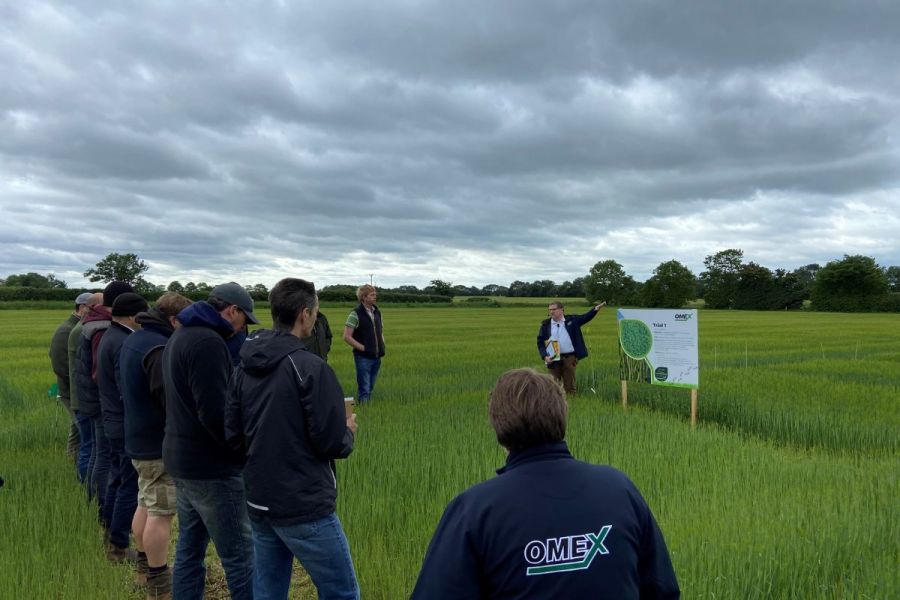Keeping nitrogen losses to a minimum is in the interests of growers, the environment and public health. CPM looks at new trials which quantify potential N losses (as ammonia) to the air and how this can be mitigated to conform with new industry guidelines.
“We’ve been running these tests back-to-back for a year, so we’ve now built up a considerable set of data.”
By Lucy de la Pasture
The inflated cost of nitrogen fertiliser over the past year has made both urea and liquid UAN (a mixture of urea and ammonium nitrate) attractive as an alternative source to ammonium nitrate forms. That may push some use a little later in the season than its traditional early spring timing.
This change in use pattern has the potential to increase ammonia losses to the air through volatilisation, which have already been targeted by the UK government for reduction due to rising levels. It’s a problem where the finger points firmly at agriculture, which is responsible for 87% of atmospheric ammonia pollution, and it’s an issue that’s being addressed by new industry rules around using urea-based fertilisers, explains David Booty, technical manager at Omex.
“A few years ago, an outright ban on urea use was mooted but after a period of industry consultation, Defra has agreed to a self-regulatory approach – which the industry will have to demonstrate is working to avoid the threat of future legislation.
“This will be applied through a new Red Tractor standard which will be published in April 2023 and come into force in October next year, though Red Tractor won’t begin to assess whether the new rules are being complied with until 2024. Manufacturer sales will also be monitored,” explains David.
The new standard will require Red Tractor scheme members to restrict the use of untreated urea to the period from 15 January to the end of March each year, starting in2024 and require treated/protected urea-based fertilisers throughout the rest of the year.
Defra’s expectation is that mitigation from the addition of urease inhibitors to urea-based fertilisers will provide a 70%, or more, reduction in ammonia emissions (see panel).
Urease inhibitors aren’t something new and not all applications will have to be protected, highlights David. “If applications are to be soil incorporated or are made before 1 April then these measures won’t apply.”
Once of the most established active ingredients to reduce volatilisation from urea is NBPT, which is widely used in the United States and proven in the UK for use with granular urea as Agrotain. More recently Limus/Limus Clear (NBPT/NPPT) has come on the market and Nutrisphere (partial calcium salt of maleic-itaconic copolymer) provides a further alternative.
Many other compounds have been investigated or promoted as urease inhibitors, for example neem, humates, ammonium thiosulfate, along with methodologies such as acidification and the addition of zinc and manganese but for these evidence of their effectiveness in the field remains largely unvalidated, says David.
With very little hard data available to quantify the ammonia reduction possible from protection measures, Omex initiated a series of trials to find out which active ingredient would best meet the Defra ammonia reduction target for use with its liquid range of UAN-based fertiliser products.
One of the key questions the trials set out to answer was whether inhibitor products performed in the same way when sulphur is included in a fertiliser, which is the case in 95% of Omex products – previous tests had concentrated on straight urea, explains David.
“Field testing to measure ammonia emissions is very complex and it’s extremely expensive to obtain results from just one trial – with its unique set of conditions – let alone replicating it, so we had to look at another way to build up a robust set of data,” he explains.
To do this Omex devised a laboratory protocol to replicate what happens to the fertiliser when applied to soil in the field, using a continuous series of in-vitro trials. “This allowed us to eliminate all the other variables that would have been encountered in the field so that the effect of the inhibitor being tested could be properly quantified.
“It’s the standard ammonia volatilisation method, validated by UCD and in the EU, for testing these materials,” adds David.
The trial was conducted using conical glass flasks with soil placed in the bottom. Fertiliser was then applied to the soil surface in a known quantity and air pumped over the treated soil, which was then passed through a vessel filled with acid to capture the ammonia released over 14 days.
“This effectively measures how much nitrogen has escaped in the form of ammonia. We’ve been running these tests back-to-back for a year, so we’ve now built up a considerable set of data and have found that NBPT has consistently averaged a reduction in volatilisation of over 70%, which is in line with the government target,” explains David.
As a result, Omex has just launched its NPBT urease inhibitor product, NitroShield, which will be available to mix with any of its liquid UAN products on the day of application.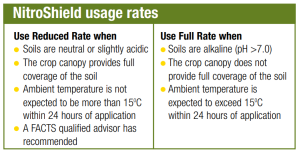
“We decided not to pre-mix any of our fertiliser products with NitroShield to remove any potential issues with inhibitor degradation during storage and to give farmers flexibility to decide whether a urease inhibitor is necessary and to determine its rate,” explains David.
As well as the continuous series of trials that have been running to measure the efficacy of its urease inhibitor, the effects of NitroShield on ammonia volatilisation from granular urea and UAN can be seen in a striking visual demonstration, using Dräger tubes inserted into the tops of four soil containing conical flasks – an untreated and the remainder treated with either granular urea, Nitroflo (UAN) and Nitroflo plus the Omex inhibitor, explains David.
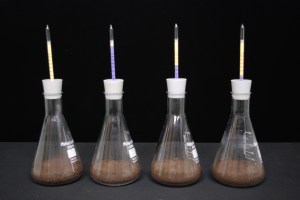
Volatilisation can be demonstrated using Dräger tubes – these contain yellow crystals which turn blue when ammonia is released.
“The Dräger tubes contain yellow crystals which turn blue when ammonia is released. The tubes are graduated in parts per million, allowing the ammonia emission to be quantified. In theory, because UAN contains 50% urea it’s logical to assume that it should volatilise at half the rate of urea. However, the trials show that this isn’t the case – UAN actually produces 72% less ammonia when applied to the soil surface than straight urea granules.”
David believes the reason for this lower rate of volatilisation is due to the form of the fertiliser. “Liquid UAN soaks into the soil within a minute when we’ve looked at this in a further trial. Even though urea granules are hygroscopic, drawing in water so that they dissolve, that process takes time – exposing the urea to the air for much longer. The liquid fertiliser is in the soil, and hence protected by it, almost from the word go so some of the risk of volatilisation is mitigated.”
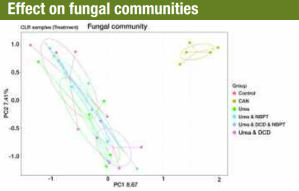
There was no significant differences between treatments for 16S rRNA. Some examples of significantly different genus between treatments are: Clonostachys – has biological control ability against numerous fungal plant pathogens; Glomus – form arbuscular mycorrhizae; Tylospora – ectomycorrhizal fungi that includes species that can grow on nitrogen sources and produce N2O and CO2. Source: Aoife M. Duff et al, 2022
Although mitigation won’t become compulsory under Red Tractor until 2024, the coming spring provides an opportunity for farmers to get to grips with the new measures. It also makes good financial sense, he says.
“In theory, reducing nitrogen losses should mean that more is available to the crop, but we wanted to quantify what this would mean on the farm under UK growing conditions. In a series of NIAB-TAG trials at Morley, liquid product 30N with NitroShield gave a yield uplift of 0.3-0.4t/ha for winter wheat over two years (2016 and 2017).
“These results have been replicated in trials in the UK, Czech Republic and Poland, with an average yield increase of 0.33t/ha. In Omex trials in 2022, the yield improvement was in line with these other trials (0.39t/ha) and we also recorded elevated grain protein (0.56%), which has also been demonstrated in a series of 10 trials in France.”
Yield increases and improved grain protein indicate a higher nitrogen use efficiency, adds David. A closer look at the figures, using NitroShield at the full rate (£8/ha), reveals the 0.33t/ha yield benefit seen in the Omex trials worth £82.50 (wheat at Nov 23, price £250/t).
“With Nitroflo 24S priced at £560/t, 100KgN cost £207/ha, giving a margin over input cost (MOIC) of £74.50/ha. That’s a better MOIC than for most inputs,” says David.
“Another way of looking at the effect of adding a urease inhibitor is rather than push yields with nitrogen, growers can look at reducing rates and maintaining yields by using their nitrogen more efficiently.
“There are lots of factors to consider when it comes to determining how much nitrogen is ‘just enough’ to support the crop and urease inhibitors are an integral part of this process, making more nitrogen available to the crop.”
The problem with ammonia
Although ammonia isn’t a greenhouse gas, it acts as a serious pollutant, explains David. “Ammonia emissions are a problem because increased levels in the atmosphere cause public health concerns, especially for people with respiratory disorders.”
But it is also a problem for the environment, he adds. “Ammonia is an issue, particularly for some of our most protected habitats designated as SSSI, because rain brings it back down from the atmosphere, effectively depositing nitrogen in rare habitats where it may be detrimental and adversely affect biodiversity, for example, in lowland heathland and acid grassland.”
Although the majority of ammonia emissions from agriculture are attributed to the livestock sector – and there are moves underway to address these – the losses connected to fertiliser use (17%) are an easier job to tackle, explains David.
“All nitrogen fertilisers can volatilise, regardless of form, but the biggest combined contribution comes from urea, responsible for 41% of fertiliser ammonia emissions and UAN contributes 19%, equivalent to around 3% of total emissions.”
Prof Tom Misselbrook at Rothamsted Research carried out the modelling studies for Defra, which predict a 70% reduction in ammonia emissions is achievable by utilising urease inhibitors. But how easy will it be to assess whether the new rules are having the desired effect on levels of atmospheric ammonia?
“We’re not going to do away with all the ammonia emissions associated with fertiliser because there will still be some emissions, even from an inhibited urea and from other fertiliser types. But there will be some significant reductions which should be quickly seen as a signal in the ammonia concentration monitoring network across the UK. So the impact on atmospheric concentrations should be fairly immediate,” he says.
“In terms of the impact on sensitive habitats, deep nitrogen deposition is a much longer-term effect because there’s been an accumulation of nitrogen in those habitats over many years. So, it will take many years of much lower nitrogen deposition to have an impact there.
“In terms of air quality, the impact should be fairly quick because if you haven’t got the ammonia in the atmosphere, it’s not combining with other gases – nitrogen oxides and sulphur dioxides – to form particulate matter, so you will get cleaner air.”
But overall, it’s going to be a relatively small impact, says Tom. “Fertiliser is only one part of the totality and urea fertiliser is only one part of fertilisers as a whole. And this is one of the problems with not just ammonia, but also greenhouse gases coming from agriculture sources, it’s from a big number of often diffuse type sources.
“One measure will never have a massive impact; it requires a raft of measures coming in to reduce emissions from a whole range of sources to have the impact we’re really looking for. And that’s why it’s complicated.
“But a lot of it does coincide with best practice. Keeping the nutrients, nitrogen in particular, within the cycle of the production system, losing less of it to the environment, is good practice and this is ultimately what we’re trying to achieve.”
So what’s Tom’s advice to farmers for 2023, before the new rules officially kick in? “If this is coming down the line, then start looking at it now. Because you’re going to be saving nitrogen then it makes sense to use an inhibitor. With fertiliser prices increasing by so much, look again at the nutrient management planning on your farm, for example, how you’re making best use of manures and other organic resources and how that fits in with fertiliser use.”
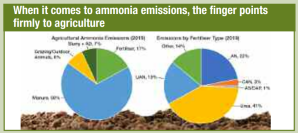
How does it work?
Urea left on the soil surface in high temperature and/or low rainfall conditions can be rapidly broken down to release ammonia gas. High pH soils increase this risk, whereas rainfall, cool temperatures, irrigation and incorporation can all mitigate it.
When urea is broken down to a form that’s available to plants (ammonium) by hydrolysis, the process is catalysed by the urease enzyme which is prevalent in soil microbial communities. This chemical reaction produces ammonia, resulting in localised increases in pH that favour ammonia loss. Urease inhibitors work by delaying this conversion of urea to ammonium.

Are there effects on soil microbes?
One of the concerns most often expressed about urease inhibitors is that they could have potential to disrupt soil biology and the ecosystem services they underpin. It’s an area where research has been minimal and often carried out in the lab rather than in the field. Of the studies conducted so far, a diversity of outcomes has been reported.
Researchers at Teagasc in Wexford, set out to answer some of the questions that hang over the use of urease inhibitors – is there an impact of fertiliser and or inhibitor use on overall microbial abundance and function in the long-term? How is the nitrogen cycling functional community impacted by the use of N fertiliser and inhibitors? What is the impact of N fertiliser formulation and inhibitor use on microbial community composition and structure?
The results were published in Soil Biology and Biochemistry earlier this year and the results provide some reassurance that there were no long-term effects on non-target bacterial and fungal communities from using NBPT on the five-year study. Microbial function and the abundance of nitrogen cycling communities were mainly unaffected by fertiliser type or inhibitors, however the application of Urea or CAN did alter fungal community structure resulting in positive or negative impacts on certain common soil genera but didn’t change bacterial composition or diversity. Overall, the researchers found the effect of fertilisation on the microbial community is greater than the impact of inhibitor use.
Source: Aoife M. Duff et al, Assessing the long-term impact of urease and nitrification inhibitor use on microbial community composition, diversity and function in grassland soil, Soil Biology and Biochemistry, Volume 170,2022, https://doi.org/10.1016/j.soilbio.2022.108709
Research Briefing
CPM would like to thank Omex for kindly sponsoring this article and for providing privileged access to staff and material used to help put the article together.
This article was taken from the latest issue of CPM. For more articles like this, subscribe here.

